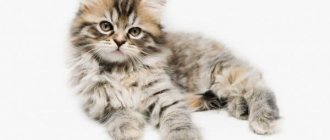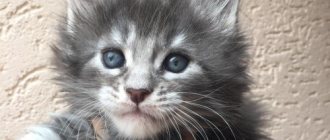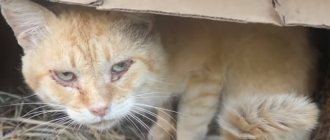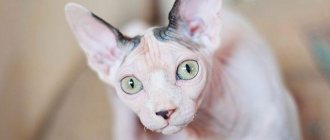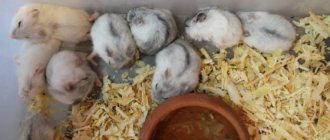Stages of a cat's life cycle
The life of any cat can be divided into several stages.
Infancy (from birth to six months)
The first six months of a baby’s life are the most significant and eventful. Ten days after birth, these are blind sucklings, whose whole world is concentrated in the warmth of the mother’s body and the nipple with milk.
By two months, kittens become quite independent, begin to feed on their own, and learn to use a litter box.
Until three or four months, the pets usually do not leave the nursery and the mother. From four to six, they resemble playful children on the cusp of adolescence.
Youth (from six months to two years)
In almost all breeds, by six months the kitten is at the beginning of puberty. Physically, he is already quite developed, almost independent.
Usually at one year the female is already able to give birth and feed kittens, although it is better if pregnancy occurs a little later, at least at 18 months. Cats mature more slowly - up to one and a half years, and in some breeds up to two or three years.
Youth (three to six years old)
Animals are considered conditionally young when they are between two and six years old. This age approximately corresponds to 20-40 years of a person. It is at the age of six that it is customary in nurseries to remove an animal from breeding.
But with good care, pets are active, healthy and capable of producing full-fledged offspring for much longer - at least up to seven to ten years.
Maturity (seven to ten years)
A cat from seven to ten years old is considered a mature individual. About the same as a person aged 40-55 years old. The animal is in the prime of life, behaves calmly and reservedly.
Older cats (eleven to fourteen years old)
From 11 to 14 years old, the cat is in old age, corresponding to human 55-70 years. If the pet does not suffer from any chronic diseases, then neither he nor the owner will have any special problems in life. Sleep time increases, whims in choosing food may appear, and there is no particular desire for outdoor games.
Old age (over fifteen years)
Pets over 15 years old can be considered 80 year olds. They are calm, unhurried, affectionate, need the attention and care of their owner, and express their devotion more clearly.
This division into age groups is very arbitrary. Many animals at 15 years old are still vigorous, playful and active. There is a known cat of the Nibelung breed that lived 36 years. She gave birth to and nursed her last kittens at 28. By the way, read about long-lived cats on our portal.
Life of a cat after surgery
After surgery, animals require increased attention and care and adherence to a strict diet.
Neutered cats urinate less frequently. As a result, they may develop urolithiasis. To minimize the risk of this disease, you should feed your pets with special food sold in pet stores.
The cat's behavior may change: he becomes lazy and inactive. Without feeling sexual desire, he may begin to eat large amounts of food and gain extra pounds of weight, which will negatively affect his health.
The operation is stressful for the animal. After the castration procedure, his temperature may rise. The risk of various diseases, including diabetes, increases.
The positive thing is that the life expectancy of a castrato increases by 1-2 years.
Life of a street and indoor cat
Life expectancy is affected by habitat. Well-groomed and caressed domestic cats live much longer than their street counterparts. The latter have to survive, get food, and hide from the cold in winter. In the cold, death from hypothermia overtakes animals quite quickly.
Kittens born in the basement or on the street die in the first months of life in 90% of cases. The reason for this is weakened immunity, lack of heat and viral diseases. Only the strongest survive, but they have yet to prove their strength in street fights. It is not surprising that they have a short life span - few live up to 7 years, and a 10-year-old street cat will be considered a long-liver.
Animals that end up outside from home find themselves in even worse conditions. Most often, the owners refuse them, indifferently throwing them away like an unnecessary rag. The chances of living at least a year on the street for cats unadapted to such conditions are negligible.
The life of a pet is a different matter. There is good food in the bowl, a warm bed in the room. Vitamins and vaccinations protect against diseases; at the slightest deviation, a caring owner will take all measures to restore the pet’s health.
general information
On that special day when a little fluffy ball appears in the house, the new owners worry little about how many years he will live.
Over time, the baby turns into a luxurious fluffy cat and takes pride of place in the family circle. As adulthood approaches, owners begin to have anxious thoughts: “How many years will the cat live?” On average, domestic cats live 10-16 years, but you need to understand that this figure depends on the breed, living conditions, nutrition, heredity and many other parameters.
Wild cats live less than domestic cats, about 5-6 years. The life expectancy of unadapted animals that were kicked out of the house is even shorter - 4 years. This is due to constant stress, the need to struggle for existence, poor quality food, severe weather conditions, illness, uncontrolled pregnancies and complications after them.
For your information: on average, cats live longer than cats, which is due to the wear and tear of the latter’s body after giving birth.
Pets that find themselves in a loving family can live up to 18-20 years. At the same time, the life expectancy of mustachioed striped animals has increased significantly in recent decades, thanks to the development of medicine.
What affects the life expectancy of cats
With proper care and the absence of genetic or chronic diseases, many indoor cats can live up to 20 years or more. The average life expectancy is 15-17 years, with spayed and neutered animals living 2-4 years longer.
Factors that reduce life expectancy
First of all, it is the habitat. Adequate and regular nutrition, absence of temperature changes, these factors significantly affect life expectancy. Unbalanced nutrition - food from the owner's table, cheap food that does not contain the required amount of nutrients and vitamins, often leads to the development of endocrine diseases and the premature death of the pet.
Also, the period depends on the breed. Genetic predisposition can be traced, as a rule, only in purebred animals. Thus, British cats easily live up to 15 years, and Persian cats - up to 20, but “classic” and “extreme” Persians do not have such longevity and rarely live even up to 15 years. However, breed itself is not an indicator of longer life. Since these cats often have genetic defects that can be caused by inbreeding. For this reason, for example, it is dangerous to knit “Scots” and “British”.
Sexual instinct is another factor influencing life expectancy. Outdoor cats may go into heat three times a year, resulting in pregnancy. Childbirth somewhere in the basement, feeding and pregnancy again greatly depletes the body, doomed to a half-starved existence. The result is a short life.
In domestic unsterilized cats and female cats, hormonal surges and the inability to realize natural instincts can lead to diseases, so in this case, sterilization actually prolongs their life.
The allotted period can be reduced by:
- lack of vaccination and preventive measures;
- free walking, which can end in death under the wheels of a car, a fight with a dog or street cat;
- infection with infectious diseases.
Factors that increase life expectancy
Important factors that will help your pet live as long as possible are:
- Proper nutrition. Food must be balanced, no matter whether it is natural or industrial food. The pet must receive the necessary vitamins and minerals. Feed must be chosen at least at the premium or super-premium level.
- Mandatory and timely vaccination, regular preventive examinations and immediate contact with a veterinarian in case of any deviations in the health and behavior of the pet.
- Sterilization or castration, after which you need to adhere to a special diet.
- Protection from dangers. For domestic cats, this is, first of all, the street, open windows and vents. It is advisable to exclude self-walking and cover the windows with special nets (mosquito nets will not help, you need an anti-cat net).
Regular removal of parasites and preventive treatment will have a positive effect on the health of the animal, and therefore on its life expectancy. Even if the cat has never gone outside in its life, it needs to be treated for fleas and helminths once every 3 months.
Factor table
| Wednesday | Domestic cats are less susceptible to viral diseases and are protected from injury. |
| Nutrition | When balanced with essential vitamins and minerals, it significantly prolongs life. |
| Genetic predisposition | Many artificially bred breeds are susceptible to some kind of disease. |
| Sterilization | Neutered cats do not suffer from reproductive pathologies and are not exposed to stress; sterilized cats live longer than those who often gave birth to kittens. |
| Stress | Street cats are constantly exposed to stress from cold, hunger, and dangers; domestic animals have a calmer life. |
| Predisposition to chronic diseases | If you start treatment in the early stages of the disease, you can significantly prolong the life of your pet; without help, animals with diabetes do not live longer than 4 years, with urolithiasis - longer than 5. |
Balanced diet
How long a domestic cat will live depends greatly on its diet. A balanced diet is a reliable building material for a pet’s body. The main question that arises for a cat owner is: “What food is considered correct?”
Most veterinarians believe that it is better to feed your cat ready-made food that contains all the minerals, nutrients, and vitamins necessary for health. But some experts suggest that such foods increase the risk of developing urolithiasis and diabetes. due to the high salt and carbohydrate content. It is better to give preference to premium and super-premium food. Manufacturers of cheap food save on protein; such products contain no more than 10% meat, the rest is vegetable protein and chemical components.
Table of average life expectancy by breed, features and diseases
| Breed | average life expectancy | Characteristic diseases and features |
| Persian | 15-20 | “Exotics” live longer than the “classical” and “extreme” Persians.
|
| Siamese | 15-20 | “Purebreds” are more likely to develop diseases than mixed breeds; there may be problems with the kidneys and eyes.
|
| British | 12-15 |
They rarely suffer from cancer, have good immunity, it is important to maintain an active lifestyle and feed them with high-quality food. |
| Scottish Fold (Scottish Fold) | 15-20 |
They have good immunity, but it is important to choose the right diet to maintain the cat’s vital activity. |
| Siberian | 15-17 |
However, 25 years is not the limit for a “Siberian” if you keep your pet properly, since it has no tendency to develop genetic diseases. |
| Russian blue | 12-16 | A domestic cat can live longer with care and affection if it is regularly shown to a veterinarian and its nutrition is properly organized.
|
| Abyssinian | 15-17 |
It is important to regularly monitor your pet's health and take your pet to the veterinarian. |
| Bengal | 12-15 |
One of the strongest and hardiest breeds, it is only important to feed and care for them correctly. |
| Sphinx | 12-15 |
With the right approach to maintenance, it can live more than 20 years, and even at such a respectable age it has excellent immunity. |
| Maine Coon | 14-16 |
|
Maine Coon
Record-breaking cats
Among the record holders are cats of aboriginal breeds - they have excellent health and great endurance.
- Lucy the cat is a British mongrel who was born in 1972 and lived for at least 45 years. Unfortunately, confirmation of this fact has not yet been found.
- Nutmeg is another British mongrel who died at the age of 32. The surprising thing is that until he was 5 years old he was an ordinary street cat.
- Rubble, a Maine Coon from England, celebrated his 32nd birthday and is still feeling great to this day.
This is what Nutmeg looked like - a record-breaking cat from England
Table of maximum life expectancy by breed
The Guinness Book of Records contains many records for life expectancy in cats. However, for most pets, some pattern can be deduced.
| Maximum age (years) | Cat breeds |
| 20 |
|
| 19 |
|
| 18 |
|
| 17 |
|
| 16 |
|
| 14 |
|
What can you do to prolong your cat's life?
Don’t despair if your pet is approaching the “average” age. Each owner can extend the life of his pet by following only a few rules:
- closely monitor the well-being of your furry friend and immediately contact a veterinarian at the slightest deviation in behavior;
- promote cat physical activity;
- do not allow self-walking;
- sterilize the animal;
- wisely select a diet containing proteins, vitamins, and minerals;
- take care and give affection to your pet, do not expose it to stress.
Approximately 30% of domestic cats suffer from chronic renal failure. It is impossible to completely cope with the disease, but if you notice it in time, you can maintain your pet’s health and significantly extend its life.
How long do cats live in human age?
It is a mistaken belief that one year of a cat's life should be equal to seven human years. In the International Veterinary Passport, the first year of a cat’s life is equated to 18 human years, and an animal that has crossed the 20-year mark is considered a long-liver: by human standards, it is already 100 years old.
Biologists have deduced the approximate age ratio of humans and cats.
Table: how to determine the age of a cat by human standards
| Cat age, months | Person's age, years |
| 1 | 1,3 |
| 2 | 2,5 |
| 3 | 3,75 |
| 4 | 5 |
| 5 | 6,3 |
| 6 | 7,5 |
| 7 | 8,75 |
| 8 | 10 |
| 9 | 11,7 |
| 10 | 12,5 |
| 11 | 13,75 |
| Cat age, years | Person's age, years |
| 1 | 15 |
| 2 | 24 |
| 3 | 28 |
| 4 | 32 |
| 5 | 36 |
| 6 | 40 |
| 7 | 44 |
| 8 | 48 |
| 9 | 52 |
| 10 | 56 |
| 11 | 60 |
| 12 | 64 |
| 13 | 68 |
| 14 | 72 |
| 15 | 74 |
| 16 | 76 |
| 17 | 78 |
| 18 | 80 |
| 19 | 82 |
| 20 | 84 |
How long a domestic cat will live depends on the person. Having taken responsibility for the life of a pet, it is important to maintain its health: properly organize nutrition and timely vaccination.
Care and attention, treating it not as a toy, but as a full member of the family, will help prolong the life of your pet.
How to determine the age of a cat by external signs and behavior
Over time, cats' appearance gradually changes, and an experienced veterinarian is able to approximately determine its age by examining the animal. You can try to independently estimate the number of years your cat has lived, but you must remember that many of the signs of aging described below may indicate a pet illness. In this case, you need to consult a doctor as soon as possible.
Teeth
The easiest way to determine a cat's age is by the color and condition of its teeth.
Young animals have white teeth, but as life goes on they become more and more yellow. A yellowish plaque on the teeth appears at the age of 3–5 years, significant yellowing is observed at 5–10 years, and at 10–12 years the teeth acquire an intense yellow color.
The condition of the teeth is assessed by incisors and canines. The first signs of wear and tear are noticeable already at 3–5 years, significant wear and sometimes loss of the incisors of the upper and lower jaw - at 5–10 years. At the same time, the cat often develops cracks and tartar forms. With age, these troubles can be compounded by gum disease.
In old age, a cat's incisors and canines gradually fall out, leaving only molars
After 10 years, incisors often fall out. If not only the incisors, but also the fangs have fallen out, and the molars have also been significantly worn out, then the cat is over 15 years old. Naturally, she must be switched to soft or semi-liquid food, otherwise she will not live long.
Note that tooth abrasion and the formation of tartar are directly related to the animal’s lifestyle and nutrition. Thanks to the care of the owner and timely solution to problems that arise in the oral cavity, a cat can have healthy teeth even in old age.
Wool
With age, a cat's coat becomes dull, the pattern becomes more blurred, and the fur is not as thick and soft to the touch as that of a young animal. Changes gradually occur from the age of 6, and closer to 10 years, when carefully examining individual hairs, gray hair can be seen.
You need to help an elderly cat care for its fur by regularly brushing it with a special brush.
Old animals may have bald spots in their fur, but this is not considered an exclusive sign of old age. Hair loss is often a symptom of the disease in cats of any age.
In general, cats have thicker fur in winter than in summer. Mechanisms of adaptation to the seasons and temperature changes also work in domestic animals.
Mustache
Like fur, cats' whiskers begin to turn gray over time. At first, individual colorless hairs appear among the whiskers; over time, their number increases and gradually all the whiskers become white. This happens closer to the animal’s 10th birthday, and sometimes earlier.
Cats' whiskers turn gray with age
Eyes
Young cats have transparent eyes, the iris is bright, clean and even. With age, it thins out, becomes heterogeneous, lines, spots, and wrinkles appear on it.
The look of an older animal is no longer as mischievous and curious as that of a young one.
After 10–15 years of life, the eyes of an old animal become dull, cataracts may develop on them, and discharge and lacrimation are often observed. You need to help your elderly pet take care of its eyes: wash them regularly and remove discharge.
